From the majestic Bald Eagle to the colorful Eastern Bluebird, Georgia is home to a diverse array of avian species.
In this article, we’ll take a closer look at 15 of the most fascinating birds found in Georgia, highlighting their unique characteristics, habitats, and behaviors.
Whether you’re a seasoned birder or just starting out, you won’t want to miss this opportunity to learn about some of the incredible feathered friends that call Georgia home.
| Image | Bird | Features | Price |
|---|---|---|---|
 |
| 9.7 | Check Price |
 |
| 9.5 | Check Price |
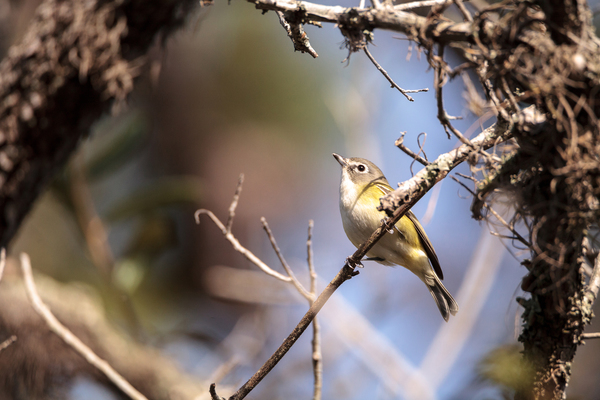 |
| 9.1 | Check Price |
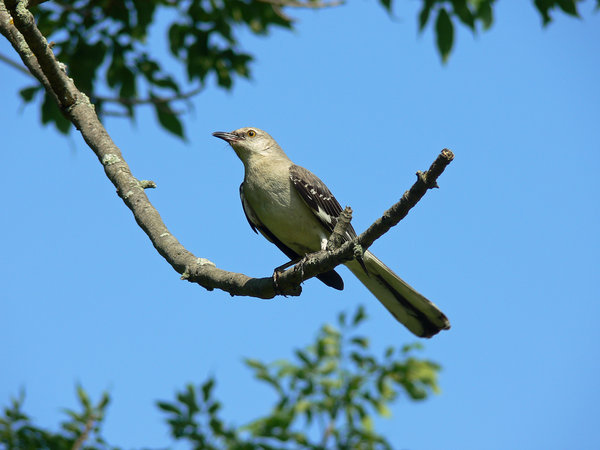 |
| 8.8 | Check Price |
 |
| 8.6 | Check Price |
 |
| 8.2 | Check Price |
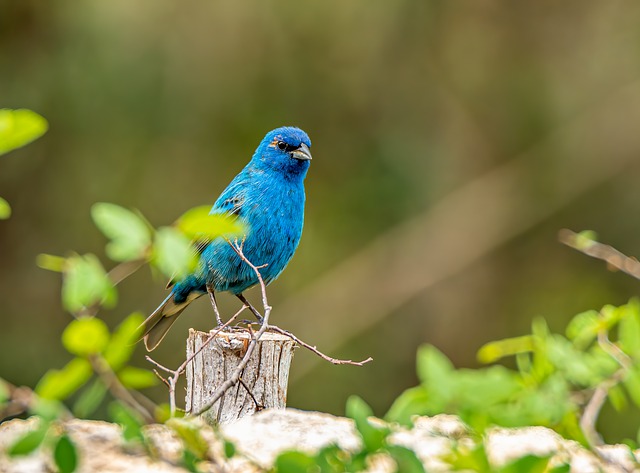 |
| 8 | Check Price |
 |
| 7.7 | Check Price |
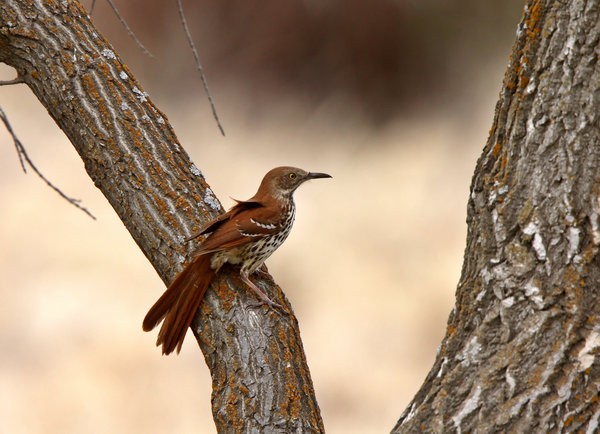 |
| 7.4 | Check Price |
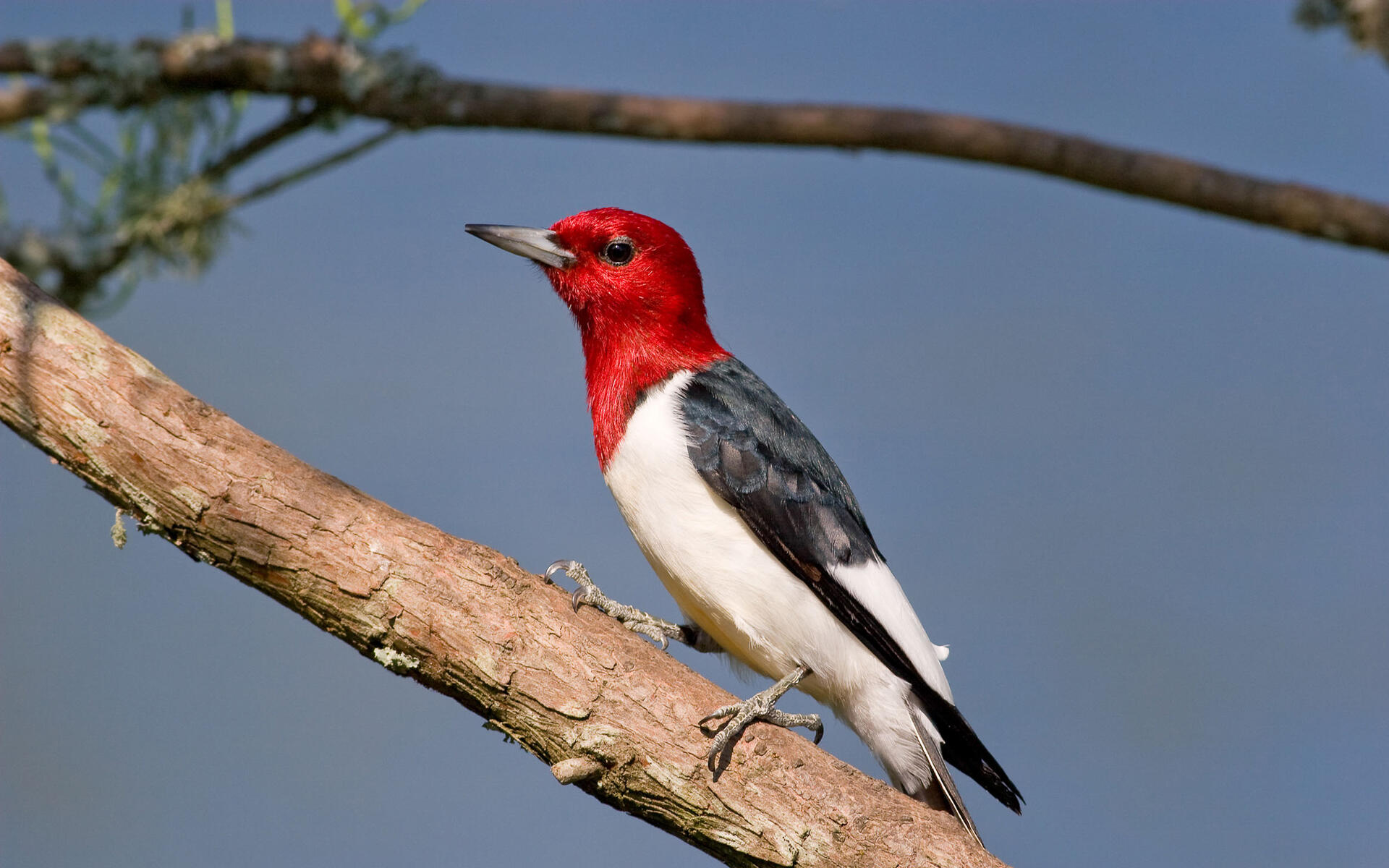 |
| 7.2 | Check Price |
 |
| 9.5 | Check Price |
 |
| 9.5 | Check Price |
 |
| 9.5 | Check Price |
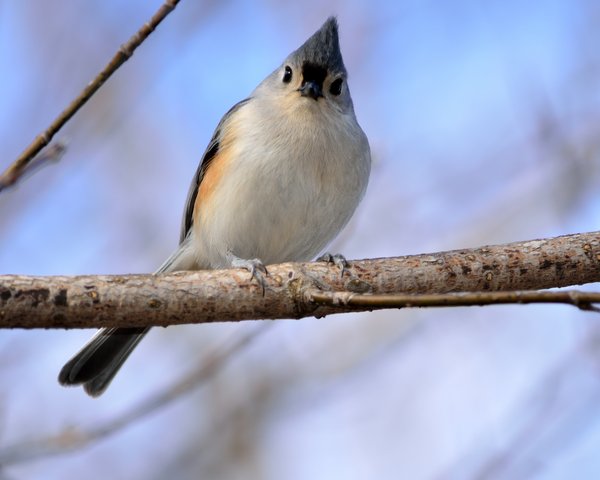 |
| 9.5 | Check Price |
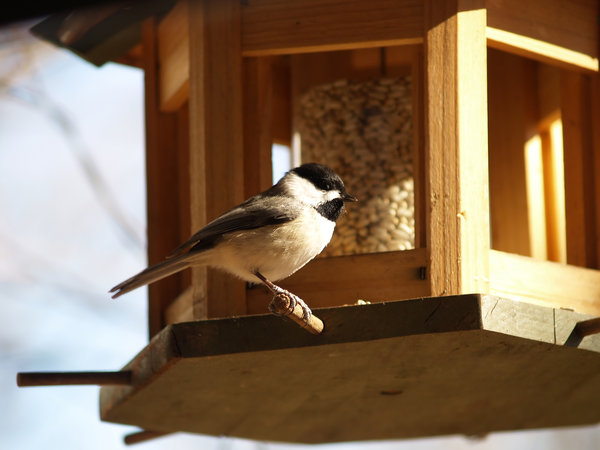 |
| 9.5 | Check Price |
If you don’t have the time to read the whole article, check out this video for a quick understanding.
Common Birds in Georgia
1. Eastern Bluebird

The Eastern Bluebird (Sialia sialis) is a tiny North American songbird that belongs to the Turdidae family.
Farmland, orchids, gardens, and open forests are the most common places to find them.
It travels widely throughout the United States, mostly to feeders. With its voice, it generates a lovely tune.
The blue wings, head, and upper parts of the Eastern Bluebird are its most distinctive features. Their necks are surrounded by an orange-brown collar. Their tail is likewise blue and has a large white belly.
They have a body length of 16 – 21 cm (6.3 – 8.3 in), a wingspan of 25 – 32 cm (9.8 – 12.6 in), and a weight of almost 27 – 34 g (0.95 – 1.20 oz).
The main variation between males and females is their color; males are blue, while females are dull blue to brownish pale.
Worms and insects, such as grasshoppers, crickets, beetles, and katydids, are the primary foods of the adult Eastern Bluebird.
Below are the characteristics of the Eastern Bluebird,
| Scientific Name | Sialia sialis |
| Length | 7 – 8 inches |
| Weight | 1 – 1.5 oz |
| Wingspan | 11 – 14 inches |
| Habitat | Open woodlands, orchards, farmlands, parks, and residential areas |
| Food | Insects, fruits, and berries |
| Nesting | tree cavities, birdhouses, and nest boxes |
| Behavior | non-migratory and are typically found alone or in pairs |
2. Northern Flicker

Northern Flicker (Colaptes auratus), Yellowhammer, and Common Flicker are all names for the same bird. It’s a woodpecker.
It is a migratory bird that spends much of its time on the move. They make their nests deep in the forest.
It is a medium-sized woodpecker, measuring around 11 – 13 inches in length and weighing around 4 – 5.5 ounces.
Its wingspan ranges from 16 – 20 inches.
The Northern Flicker is similar to the Downy Woodpecker in appearance, but it lacks the red dot above the head and has duller plumage.
The bird’s plumage is brown, white, and black.
The underparts and belly are brownish greys with black spots, while the upperparts and wings are brown with black dots.
Both males and females have pinkish feathers at the base of their tails.
Northern Flickers are identical in appearance to females, but males have a redneck ring that females lack. In addition, males are larger, heavier, and have longer wingspan than females.
The male employs a melodic high-pitched tone to entice females for reproduction. They come to feeders in various places on a regular basis.
During the summer, they come to the feeders to collect food.
Insects, larvae, worms, seeds, nuts, and various berries are the most common foods they consume.
Below are the characteristics of the Northern Flicker,
| Scientific Name | Colaptes auratus |
| Length | 11 – 13 inches |
| Weight | 5 – 6 oz |
| Wingspan | 16 – 21 inches |
| Habitat | Woodlands, forests, and suburban areas, often seen in open fields and near human habitation |
| Food | Ants, beetles, and other insects, fruits, and berries |
| Nesting | cavities in trees, woodpecker holes, or nest boxes |
| Behavior | migratory |
3. White-eyed Vireo

One of the tiniest songbirds in North America is the White-eyed Vireo, commonly known as Vireo griseus.
The White-eyed Vireo is a migratory bird that migrates from northern North America to southern and Central America.
The White-eyed Vireo’s plumage is stunning and vibrant. Olive-colored feathers cover the head and throat of this bird.
The bird’s top portions, back, and wings are olive to dark, with black and white flanks.
In their eyes, there is a white ring. They have yellow underbelly.
A White-eyed Vireo’s body length can range from 4.3 to 5.1 inches (11 to 13 cm), with a wingspan of almost 6.7 inches (17 cm).
Three to six eggs are laid by the female White-eyed Vireo. The eggs are sat on by both the male and female until they hatch.
They make open nests in the form of a cup.
The White-eyed Vireo feeds on a variety of insects and worms. They consume tiny seeds, nuts, and berries from many plants as well.
They are known to frequent bird feeders in the United States of America.
Below are the characteristics of the White-eyed Vireo,
| Scientific Name | Vireo griseus |
| Length | 5 inches |
| Weight | 0.4 oz |
| Wingspan | 7.5 inches |
| Habitat | Woodlands, forests, and suburban areas, often seen in thickets, bushes, and trees |
| Food | Insects and spiders |
| Nesting | thickets and bushes |
| Behavior | migratory and are active during the day |
4. Northern Mockingbird

The Northern Mockingbird, commonly known as Mimus polyglottos, is North America’s sole mockingbird species.
It is a medium-sized songbird, measuring around 9.5 – 11 inches in length and weighing around 2.5 – 3.5 ounces.
Its wingspan ranges from 14 – 16 inches.
This species does not migrate and is a permanent inhabitant of northern states.
They regularly visit the bird feeders’ backyards in search of food.
Grey upper parts and whitish-grey underparts characterize the Northern Mockingbird.
The bird is taller and has a longer tail than many other birds of its size.
The male Northern Mockingbird has the same plumage color as the females and is about the same size, shape, and wingspan as the females.
In terms of weight, males outnumber females. Their long tail and wings also have black feathers on them.
Northern Mockingbirds have a 20-year lifespan. Bird feeders in various locations are frequented by them.
Tiny grains, grass seeds, fruits, berries, worms, and small insects are favorites of the Northern Mockingbird.
Below are the characteristics of the Northern Mockingbird,
| Scientific Name | Mimus polyglottos |
| Length | 9.5 – 11 inches |
| Weight | 2 – 2.5 oz |
| Wingspan | 12 – 15 inches |
| Habitat | Woodlands, forests, and suburban areas |
| Food | Insects, fruits, and berries |
| Nesting | shrubs, bushes, and trees |
| Behavior | non-migratory |
5. Pileated Woodpecker

The Pileated Woodpecker, commonly known as the Dryocopus Pileatus, is a medium-sized woodpecker that is native to the United States.
The pileated red crown of this bird is particularly well-known. The red crest on top of its head makes it easy to spot them.
Except for their red cap/crest atop their heads, they resemble the other woodpecker species.
They are distinguished from other Woodpecker species by their distinctive cap.
The typical body size of an adult Pileated Woodpecker is 17 inches, with a wingspan of about 28 inches.
An adult woodpecker can weigh anything from 8 to 24 ounces.
Pileated Woodpecker males and females have slightly distinct appearances.
Males have a red line from their beaks to their necks, while females have a black line.
The males’ wings are black, while the females’ are somewhat brown.
They, like all other woodpeckers, boreholes in tree trunks.
They eat from the bird feeders on a regular basis.
They consume a variety of insects, worms, larvae of worms and insects, grass seeds, and tiny grains.
They consume a variety of fruits, berries, and vegetables as well.
Below are the characteristics of the Pileated Woodpecker,
| Scientific Name | Dryocopus pileatus |
| Length | 16 – 19 inches |
| Weight | 10 – 12 oz |
| Wingspan | 26 – 29 inches |
| Habitat | Old-growth and mature forests, woodlands with large trees, and suburban areas with large trees |
| Food | Insects, especially ants and wood-boring beetles, fruits, and berries |
| Nesting | cavities in large trees |
| Behavior | non-migratory |
6. Cedar Waxwing

The Cedar Waxwing, also known as the Bombycilla cedrorum, is a medium-sized bird that belongs to the Bombycillidae (Waxwing) family of birds.
It’s a passerine songbird with a high-pitched call used for communication.
The Cedar Waxwing is one of the tiniest waxwing species found in North America.
The Cedar Waxwing is a brown bird with glossy silky grey and lemon yellow patterns on its plumage.
In addition, they wear a black mask that covers their full face.
A brilliant red dot sits in the center of brown silky feathers on their wings.
This bird also has a brown crest on top of its head.
The eyes of the Cedar Waxwing are black, and a stripe runs from the eyes to the rear of the head.
Their beak is short, yet it is powerful enough to crack nuts and tiny insects.
The Cedar Waxwing has a body length of about 6 – 7 inches (15 – 18 cm) and a wingspan of 8.7 – 11.8 inches (22 – 30 cm).
An adult Cedar Waxwing bird weighs around 30 grams.
The female Cedar Waxwing waits on the eggs while the male breeds in the open woods.
The male takes care of the female until the eggs hatch, after which the female can fly away and look for food.
Cedar Waxwing consumes a variety of tiny berries and fruits from small plants such as junipers, dogwood, serviceberry, and cedar.
Caterpillars, spiders, and worms are among the tiny creatures consumed by this bird.
If they nest near a human area, they will also frequent bird feeders to acquire some food.
Below are the characteristics of the Cedar Waxwing,
| Scientific Name | Bombycilla cedrorum |
| Length | 7 inches |
| Weight | 0.7 oz |
| Wingspan | 12 inches |
| Habitat | Woodlands, forests, and suburban areas are often seen in open fields, gardens, and orchards |
| Food | Fruits and insects |
| Nesting | shrubs, bushes, and trees |
| Behavior | non-migratory |
7. Indigo Bunting

The Indigo Bunting, commonly known as the Passerina cyanea, is a tiny seed-eating bird belonging to the Cardinalidae family.
This bird is native to North America, but during the winter, it migrates to the southern United States.
They have the ability to see in the dark and even at night. When migrating, they primarily migrate at night and spend their days looking for food.
The Indigo Bunting is so named because its plumage is indigo blue in hue.
The male Indigo Buntings have a gleaming blue indigo plumage that covers their wings, back, face, upperparts, belly, and underparts; the females, on the other hand, are brown.
In addition, the male Indigo Bunting’s wings have a blackish tint. Females have a grey-white underbelly and brown and dark brown upperparts.
An adult Indigo Bunting bird’s body length ranges from 11.5 – 13 cm (4.5 – 5.1 in) to 18.5 – 23 cm (7.1 – 9.1 in), with a wingspan of almost 18 – 23 cm (7.1 – 9.1 in).
A breeding male bird can weigh anything from 11.2 – 21.4 g (0.40 – 0.75 oz.) as an adult.
The Indigo Bunting is well-known for its seed-eating habits since they rely nearly completely on seeds found in fields.
They scour the ground for seeds, which they consume.
They consume grains, fruits, berries, and vegetative materials in addition to seeds.
Below are the characteristics of the Indigo Bunting,
| Scientific Name | Passerina cyanea |
| Length | 5 – 6 inches |
| Weight | 0.4 oz |
| Wingspan | 8 – 9 inches |
| Habitat | Open woodlands, thickets, fields, and suburban areas |
| Food | Insects, seeds and berries |
| Nesting | bushes and trees |
| Behavior | migratory |
8. Brown-headed Cowbird

The Molothrus ater, often known as the Brown-headed Cowbird, is a medium-sized North American bird.
The Brown-headed Cowbird is a migratory bird that moves about based on food supply, weather, and climate conditions.
The bird is shaped like a regular crow, but its back is more colorful.
During the summer, they frequently go to the north.
Except for the head and neck, which are brown instead of black, the Brown-headed Cowbird has all-black plumage.
Rather than being pure black, this bird’s black plumage is more bluish-black. Males have shinier, brighter plumage than females.
The female has brown and black plumage.
Females are smaller, have shorter wingspans, and weigh less than males.
Females are easily distinguishable from males in the flock due to their distinct coloration.
To attract females for mating, the bird creates a high-pitched song.
They are migratory birds that migrate from one location to the next.
Insects, worms, plant seeds, fruits, and berries are among the foods consumed by the Brown-headed Cowbird.
Below are the characteristics of the Brown-headed Cowbird,
| Scientific Name | Molothrus ater |
| Length | 7 – 8 inches |
| Weight | 1 – 1.5 oz |
| Wingspan | 12 – 14 inches |
| Habitat | Grasslands, prairies, and agricultural areas |
| Food | Mostly insects, but also seeds and berries |
| Nesting | bushes and trees |
| Behavior | non-migratory |
9. Brown Thrasher

The Brown Thrasher, also known as Toxostoma rufum, is a big bird belonging to the Mimidae family of thrashers. Mockingbirds are genetically linked to birds.
The Brown Thrasher is a bird that may be found in rocky areas throughout the United States and other parts of the world.
The bird is completely coated in brown plumage, as its name indicates. Above their wings and upper portions of the plumage, they have dark brown to black patches.
The bird’s body is coated with brownish-grey plumage on the underparts, belly, and breasts.
Because the male and female Brown Thrasher birds are so similar in form, color, and size, it’s difficult to tell them apart.
Brown Thrasher chicks are born with drab coloring and no feathers.
Brown Thrashers have a wingspan of 29 to 33 cm and a body size of 23.5 to 30.5 cm (9.3 to 12.0 in) (11 to 13 in).
A Brown Thrasher adult weighs between 61 and 89 grams on average (2.2 to 3.1 oz).
The male is somewhat larger than the female.
The female Brown Thrasher lays three to five eggs, which she waits on until they hatch. These days, the male supplies nourishment.
The Brown Thrasher mostly feeds on tiny insects and worms.
Small insect larvae are also eaten by them. Some birds’ seeds, grains, fruits, and berries are also eaten by the Brown Thrasher.
They will come to the bird feeders on a regular basis if the feeders contain suet and other such items.
Below are the characteristics of the Brown Thrasher,
| Scientific Name | Toxostoma rufum |
| Length | 10 – 11 inches |
| Weight | 2.5 – 3.5 oz |
| Wingspan | 15 – 16 inches |
| Habitat | Woodlands, forests, and suburban areas, often seen in thickets, bushes and trees |
| Food | Insects, fruits, berries, and also small invertebrates and snails |
| Nesting | thickets and bushes |
| Behavior | non-migratory |
10. Red-headed Woodpecker
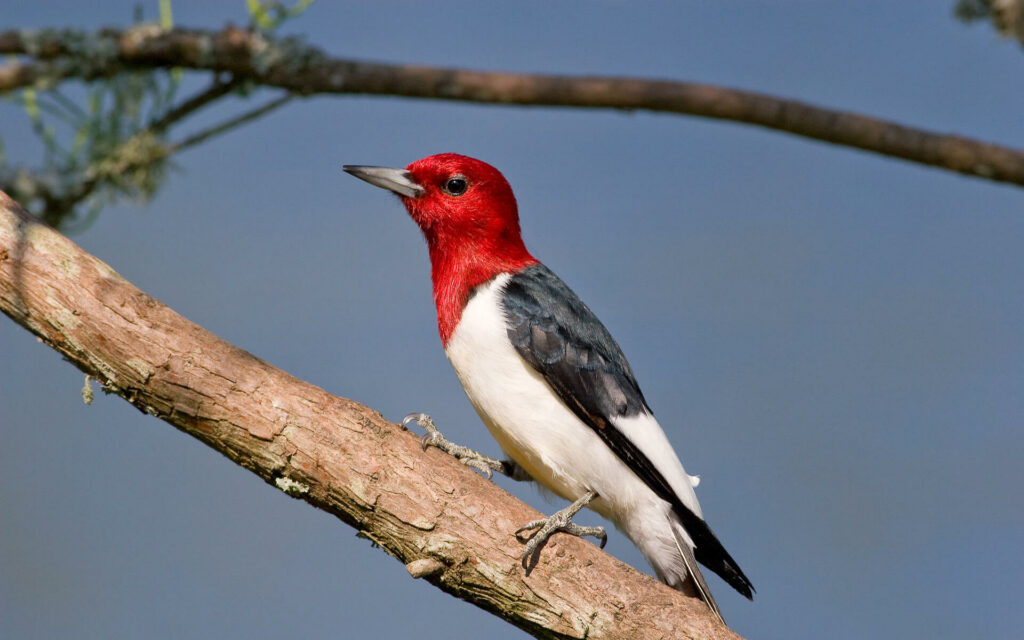
Melanerpes erythrocephalus, popularly known as the Red-headed Woodpecker, is a tiny woodpecker bird native to North America.
They are migratory birds that spend the winter migrating from the north to the south.
The name Red-headed Woodpecker alludes to the bird’s gleaming reddish-brown head.
This bird has lovely, gleaming plumage. Their backs are black with a pattern of black, white, and black. Their tail is also black.
They have a powerful, pointed beak that they utilize to peck at tree trunks. The belly, underparts, and breasts of the Red-headed Woodpecker are all white.
The male and female have plumage that is identical in the cooler.
The head of the juvenile Red-headed Woodpeckers is grey.
Adult Red-headed Woodpeckers have a body length of 19 to 25 cm (7.5 to 9.8 in) and a wingspan of up to 42.5 cm (7.5 to 9.8 in) (16.7 in).
A Red-headed Woodpecker can weigh anything from 56 to 97 grams as an adult (2.0 to 3.4 oz).
The Red-headed Woodpecker is well-known for its capacity to peck holes in tree trunks and dwell within them.
The insects that this bird eats are usually caught in mid-flight by this species.
They don’t usually eat from the ground.
They mostly search for food in treetops. Small seeds, nuts, and cereals are also among their favorite foods.
They also go to the bird feeders’ backyards to eat.
Below are the characteristics of the Red-headed Woodpecker,
| Scientific Name | Melanerpes erythrocephalus |
| Length | 9 – 10 inches |
| Weight | 2.5 – 3 oz |
| Wingspan | 16 – 20 inches |
| Habitat | Open woodlands, forest edges, and suburban areas |
| Food | Insects, fruits, and berries |
| Nesting | trees, woodpecker holes, or nest boxes |
| Behavior | non-migratory |
11. White-throated Sparrow

The Zonotrichia albicollis, often known as the White-throated Sparrow, is a tiny passerine songbird belonging to the Passerellidae family of new world sparrows.
Their throats are white, as the name implies. Yellow dots appear in their eyes.
White, black, and white stripes adorn the head of the White-throated Sparrow bird. White-throated Sparrows have brownish-white breasts and underparts.
Black, brown, and white stripes run over the shoulders, back, and wings of the White-throated Sparrow.
They have a brownish tail as well. Males and females differ somewhat.
A White-throated Sparrow’s body length ranges from 15 to 19 cm (5.9 to 7.5 in), with a wingspan of about 23 cm (9.1 in).
A White-throated Sparrow can weigh anything from 22 to 32 grams as an adult (0.78 to 1.13 oz).
In bushy places, the White-throated Sparrow makes its nest.
Small seeds and grains are consumed by the White-throated Sparrow. Small nuts, berries, and fruits are also enjoyed by the White-throated Sparrow.
Small insects and worms of various types are also eaten by the White-throated Sparrow.
They also come to feed the birds at the bird feeders.
Below are the characteristics of the White-throated Sparrow,
| Scientific Name | Zonotrichia albicollis |
| Length | 6 – 7 inches |
| Weight | 0.8 – 1 oz |
| Wingspan | 8 – 10 inches |
| Habitat | Woodlands, forests, and suburban areas |
| Food | Seeds, insects, and berries |
| Nesting | thickets and bushes |
| Behavior | migratory |
12. Ruby-throated Hummingbird

The Ruby-throated Hummingbird (Archilochus colubris) is a tiny North American hummingbird.
The Ruby-throated Hummingbird gets its name from the color of its neck, which is ruby in hue.
During the winter, they migrate south as a migratory hummingbird species.
The Ruby-throated Hummingbird has metallic-green top parts and white-grey underparts.
They have a large beak and blackish-brown wings.
They sip nectar from a variety of flowers using their bill.
Female Ruby-throated Hummingbirds seem identical to males, but their throats aren’t as red as the males’.
A Ruby-throated hummingbird’s body length ranges from 7 to 9 cm (2.8 to 3.5 in), while its wingspan ranges from 8 to 11 cm (3.1 to 4.3 in).
A Ruby-throated hummingbird can weigh anything from 2 to 6 grams as an adult (0.071 to 0.212 oz).
They’re little birds. They have a large bill, which they utilize to drink nectar from a variety of flowers, including a variety of garden plants.
They sip nectar from the flower’s ovary with their lengthy beak.
During their migration and flight, they also consume tiny insects and worms.
They also pay a visit to the suet and sugared water bird feeders in people’s yards.
Below are the characteristics of the Ruby-throated Hummingbird,
| Scientific Name | Archilochus colubris |
| Length | 3 – 3.5 inches |
| Weight | 0.1 – 0.2 oz |
| Wingspan | 4 – 5 inches |
| Habitat | Woodlands, forests, and suburban areas |
| Food | Nectar from flowers, insects, and spiders for protein |
| Nesting | trees, bushes and shrubs |
| Behavior | migratory |
13. White-breasted Nuthatch

The White-Breasted Nuthatch (Sitta carolinensis) is a tiny songbird that belongs to the nuthatch family.
They thrive in moderate North American climates.
Their tail is short, and they have large head, powerful beak, and strong feet.
Their face, sides, and chests are all white, with black caps and blue-gray back.
They come in nine distinct colors, which make it easy to distinguish between them.
White-breasted Nuthatches have a maximum body length of 14 cm (5.5 inches), and a maximum wingspan of 27 cm (almost 10 inches).
They weigh anything from 0.6 to 1.0 ounces. Males and females have slightly varied body forms and back colors.
Depending on the occasion, they may create a variety of tunes. They frequent bird feeders in search of food.
Insects and seeds from tiny plants and bushes are their main sources of food.
They also consume and store the nuts of various plants in tree trunks, such as hickory, which they devour throughout the winter season.
Below are the characteristics of the White-breasted Nuthatch,
| Scientific Name | Sitta carolinensis |
| Length | 4.5 – 5 inches |
| Weight | 0.7 – 1 oz |
| Wingspan | 7 – 8 inches |
| Habitat | Woodlands, forests, and suburban areas |
| Food | Insects, seeds, and nuts |
| Nesting | cavities in trees |
| Behavior | non-migratory |
14. Tufted Titmouse

The Tufted Titmouse, or Baeolophus Atricristatus, is a tiny North American songbird. Its head is crowned with a black crest.
An adult Tufted Titmouse’s body length ranges from 5.6 to 6.2 inches (13 – 16 cm), with a wingspan of 7.9 – 10.2 inches (20 – 26 cm) and a body weight of 20 to 26 grams (0.6 to 1 oz.).
Both males and females have the same physical form, weight, and size.
They appear to be the same, but their tufted crest allows you to distinguish them.
The Tufted Titmouse has a grey upper body and a white belly.
They have rust-colored flanks and a rust-colored upper body.
The Tufted Titmouse has a black forehead and a tufted grey crest/crown on top of their heads.
They have a very lovely and beautiful tune with around 20 distinct beat variants.
They employ these various rhymes in various situations, resulting in a distinct type of song depending on the circumstances.
They do not make an open nest like many other birds; instead, they exploit the gaps in tree trunks to build their nests inside.
They enjoy grains, seeds from a variety of tiny plants, and herbs. Small berries, nuts, and fruits are among their favorite foods.
Caterpillars, insects, ants, wasps, and hornets are also among the Tufted Titmouse’s favorite foods.
Below are the characteristics of the Tufted Titmouse,
| Scientific Name | Baeolophus bicolor |
| Length | 6 – 7 inches |
| Weight | 0.8 – 1 oz |
| Wingspan | 9 – 11 inches |
| Habitat | Woodlands, forests, and suburban areas |
| Food | Insects, seeds, nuts, fruits and berries |
| Nesting | cavities in trees, woodpecker holes, or nest boxes |
| Behavior | non-migratory |
15. Carolina Chickadee

The Poecile carolinensis, or Carolina Chickadee, is a tiny passerine bird that belongs to the Paridae family of birds.
They may be found in the woods and around bodies of water.
The Carolina Chickadee has a black crown on its head and a white line running from its eyes to its wings. Near the neck, there is a dark black cord.
The bird has grey-brown upper parts and wings.
Light brown underparts and breasts distinguish the Carolina bird.
A long tail is another feature of the Carolina Chickadee. Their beak is small yet powerful.
An adult Carolina Chickadee’s body length ranges from 11.5 – 13 cm (4.5 – 5.1 in) to 15 – 18 cm (6 – 7 in).
The typical weight of an adult Carolina Chickadee is 9 – 12 g (0.32 – 0.42 oz).
The male and female are nearly similar and difficult to distinguish. To defend itself and its eggs from predators, this bird makes a nest deep in the woods.
The Carolina Chickadee is an insectivorous bird that feeds on tiny insects, including larvae and eggs of various insects.
They also consume tiny grains, shrubs, and plant seeds. They also consume tiny berries, nuts, and fruits.
They also go to the region’s bird feeders to obtain some food.
They mostly frequent bird feeders that give suet as a food source.
Below are the characteristics of the Carolina Chickadee,
| Scientific Name | Poecile carolinensis |
| Length | 4.5 – 5 inches |
| Weight | 0.3 – 0.4 oz |
| Wingspan | 7 – 8 inches |
| Habitat | Woodlands, forests, and suburban areas |
| Food | Insects, seeds, nuts, and fruits |
| Nesting | cavities in trees, woodpecker holes, or nest boxes |
| Behavior | non-migratory |
Conclusion
This article illustrates all of the common birds in Georgia at different seasons of the year.
They are the most common birds seen in Georgia throughout the summer (June and July) and winter (December and January).
To Conclude, These are the common birds of Georgia,
- Eastern Bluebird
- Northern Flicker
- White-eyed Vireo
- Northern Mockingbird
- Pileated Woodpecker
- Cedar Waxwing
- Indigo Bunting
- Brown-headed Cowbird
- Brown Thrasher
- Red-headed Woodpecker
- White-throated Sparrow
- Ruby-throated Hummingbird
- White-breasted Nuthatch
- Tufted Titmouse
- Carolina Chickadee
FAQ
What is Georgia's state bird?
The Brown Thrasher (Toxostoma rufum) is the state bird of Georgia. It was designated as the official state bird in 1935.
What are some common types of birds found in Georgia?
Some common types of birds found in Georgia include the Bald Eagle, Eastern Bluebird, Northern Flicker, Northern Mockingbird, and the Red-tailed Hawk, among others.
What is the best time of year to see birds in Georgia?
Spring and fall are the best times of year to see birds in Georgia, as many species migrate through the state during these seasons.
Where are the best places to go birdwatching in Georgia?
Some of the best places to go birdwatching in Georgia include the Okefenokee National Wildlife Refuge, Jekyll Island, and the Georgia Coast.
Is it legal to keep wild birds as pets in Georgia?
No, it is illegal to keep wild birds as pets in Georgia, as well as in most of the United States, unless you have a permit from the government.
What should I do if I find an injured bird in Georgia?
If you find an injured bird in Georgia, contact a local wildlife rehabilitation center or the Georgia Department of Natural Resources for assistance.
Last Updated on March 22, 2023 by Lily Aldrin
